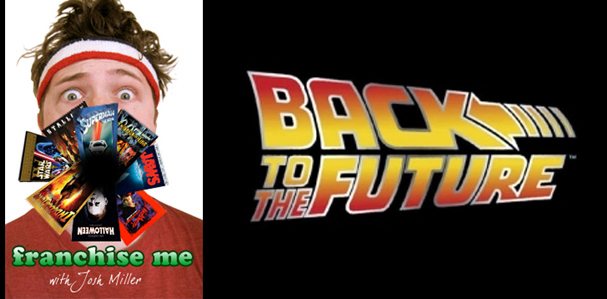
Hollywood loves a good franchise. The movie-going public does too. Horror, action, comedy, sci-fi, western, no genre is safe. And any film, no matter how seemingly stand-alone, conclusive, or inappropriate to sequel, could generate an expansive franchise. They are legion. We are surrounded. But a champion has risen from the rabble to defend us. Me. I have donned my sweats and taken up cinema’s gauntlet. Don’t try this at home. I am a professional.
Let’s be buddies on the Facebookz!
Buy my newest book!
The Franchise: Back to the Future: following the time-traveling adventures of teenager Marty McFly, eccentric inventor Dr. Emmett “Doc” Brown, and Brown’s creation, a 1981 DeLorean DMC-12 that has been modified into a time-machine. From 1985 to 1992, the franchise spanned three films and an animated television series.
The Installment: Back to the Future (1985)
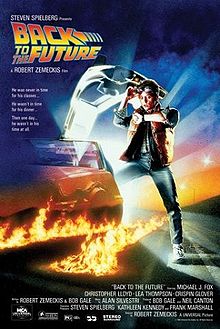
The Story:
Marty McFly (Michael J. Fox) is a teenage, wannabe rockstar and avid skateboarder who for some reason is best friends with an elderly crackpot inventor, Doc Brown (Christopher Lloyd). When Brown dupes some Libyan terrorists into giving him stolen plutonium, he uses the rare material to turn the only car the failed DeLorean Motor Company ever produced into a time machine. The Libyans are pissed, so they kill Brown. Left with little options for escape, Marty hops in the DeLorean and accidentally travels back to 1955 and accidentally prevents his parents from falling in love. Now, not only does Marty need to figure out how to get back to 1985, but he needs to get his parents together so that they’ll hump someday and prevent him from winking out of existence. Cause if that happens, how will he ever become a rockstar!?!
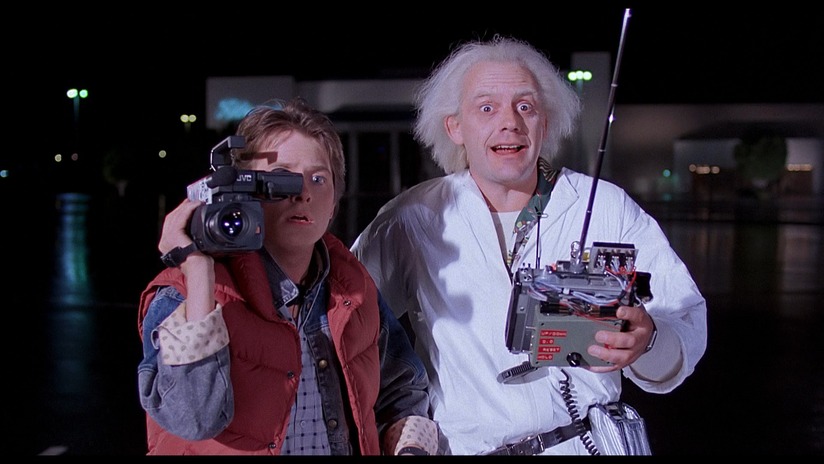
What Works:
I generally don’t like to discuss films in Franchise Me from the perspective of the present day, but Back to the Future is a special sort of classic. Film geeks may find the time to visit and fall in love with certain films made before they were born, and the Internet has only made it easier for generational darlings (be they of the Caddyshack or Goonies variety) to keep up a strong level of awareness. But aside from animated Disney films, very few older films manage to become peer group touchstones for newer and newer generations. Like a phoenix, Back to the Future keeps rising up to grab young viewers. This endless rebirth has rendered it a perfect movie, which makes objectively discussing it as though it were currently 1985 a little fruitless. It is impervious to perceived criticisms now. Fittingly, Back to the Future is timeless. So it is from this perspective that I want to look at the film…
I think the film’s staying power lies foremost in its very concept. It isn’t that time travel is such an overpoweringly appealing concept. If that were true we’d be living in a world were I might have readers clamoring to discuss a Timeline or Black Knight franchise. No, it is the nature of Robert Zemeckis’ and co-writer Bob Gale’s specific use of time travel that poised the film for timelessness. Back to the Future falls into the Connecticut Yankee in King Arthur’s Court time travel subgenre, which explores the humorous cultural aspects of time travel more so than the sci-fi or adventure aspects. Audiences always enjoy seeing a modern man travel back in time and dominate the past by simply using his modernness — possibly because this carries with it the suggestion that the audience is better off or superior to the breadth of humanity that came before; who knows. To that end, much of the film’s humor comes from poking fun at the 1950s, the time-period’s quaint backwardness (thinking a DeLorean is a spaceship) and innocence (inability to embrace Van Halen-style electric guitar) and simply the things people don’t have yet (Tab diet soda). This of course worked like crazy in 1985. In theory, though, this should have hurt the film as 1985 slowly became “the past.” Normally becoming dated hurts a film’s ability to connect with new audiences. Yet, with Back to the Future it actually has helped keep it fresh. The film dealt with a 30 year gap, and it is now almost 30 years since 1985. Back to the Future has survived because the tone of its time travel gags has allowed its dated qualities to transform into new jokes — just like Lou the cafe owner, today’s kids have no idea what Tab or Pepsi Free are either. So instead of needing to look at the film through a context prism (which only film fans are generally capable of or at least interested in doing), kids now can simply view 1985 the same way kids in the ’80s viewed 1955. And since the bulk of the film was always in 1955 anyway, the audience isn’t asked to relate to ’85 Marty for very long. I don’t think Zemeckis or Gale could claim this was part of their agenda, but it happened anyway. Though they can take credit for making a time travel movie that focuses more on very relatable parent-child dynamics than the actual time travel element. But more on that in a moment.
For all its great ideas and wonderful bits, Back to the Future‘s script is actually riddled with the kinds of problems that might normally have prevented the film from rising above “good.” The film’s first twenty minutes have a copious amount of set-up needed for pay-off gags and plot-points in 1955, but one of the more relevant details is completely left out — why and how did Marty and Doc Brown become friends? Marty likes to use Doc’s giant speaker. Is that it though? How did Marty even know Doc had that speaker? Does Marty work for Doc in a paying capacity? What is that opening scene in which Marty destroys the Doc’s speaker supposed to tell us about the character? That he’s reckless? Likes extremes? He doesn’t show any signs of guilt over the destruction. So is he careless? None of those prove true or influence his actions later in the film. It is just a flashy opening, and all we actually learn about him during his intro is that he likes rock’n’roll and is skilled at skateboarding. So what is Marty’s deal? Hard to truly say, since he doesn’t have a personal goal that is fulfilled by the narrative. His big set-up “character moment” is when his band doesn’t get to play the high school dance. Then Marty plays guitar at the dance in 1955, but as far as we’re shown, this in no way leads to any present day success for him or his band. Since we’re never told that Marty hasn’t played in public before, his Enchantment Under the Sea display isn’t much of a triumph. Marty has no personal arc. He has no flaws or weaknesses, so he doesn’t need to learn anything about himself in the past. He learns more about his parents, but that doesn’t help him connect with them better, because the original 1985 George and Lorraine cease to exist at the end of the film. The happy ending is simply that Marty inadvertently made his parents’ lives better, which in turn made his own life better — though all these happy changes occurred in an alternate timeline that Marty did not get to personally experience, so he has remained the exact same Marty he always was. Thus, no personal growth. He didn’t change, he changed his surroundings to better fit his own desires. But none of this matters whatsoever. You don’t even think about it. Zemeckis effortlessly glides over a sea of missing details and screenwriting textbook no-nos, proving that in the end there is no textbook. Your movie works or it doesn’t. And Back to the Future really works.
Robert Zemeckis’ touch on this film can’t be overestimated. Before moving towards Oscar-bait and before falling in love with the dead-eyed horrors of motion capture, Robert Zemeckis had a perfect decade encapsulated with the 1980s. For those not that familiar with his career, Zemeckis started off in 1978 with the charming but light nostalgia piece I Wanna Hold Your Hand, before unleashing one of the most gorgeous mainstream directing streaks Hollywood has ever seen — Used Cars, Romancing the Stone, Back to the Future, Who Framed Roger Rabbit, and Back to the Future II and III. Even the mighty Spielberg never managed that many stellar films in succession without a Hook popping up. Of course, once the ’90s showed up Zemeckis had plenty of Hooks. But point being, 1985 found the man at the height of both his powers and his game. Back to the Future‘s tone is just heavenly. Wading through some of the initial set-up takes time, but once Marty and Doc are together the film starts to feel magical. And this is before Zemeckis started getting showy with his style. The moment when we first see Doc and the DeLorean is actually somewhat bland if you really break down the shot compositions, but Zemeckis’ slow pull in on Marty looking on in wonder (a classic Spielberg move) is all we need. Plus, Alan Silvestri’s score heightens the moment. (Silvestri is practically John Williamsian in his use of character themes in BTTF, giving us faints hints or a few bars at key junctures, as if to say, “Hey, heads up, something cool is about to happen here.”) Once Marty gets to 1955 the film just hauls ass pacing-wise. Everything clicks. Especially the performances.
The cast is great. Lea Thompson nails that blend of sweet innocence and secretly slutty. Crispin Glover is so weird. At times it seems like he is giving us too much, but Zemeckis restrains Glover hovering right at the edge, and the end result is quite electrifying. George McFly is an indelible performance. But of the supporting cast I think Thomas F. Wilson as Biff Tannen is the secret weapon. Biff is obviously a great and memorable character, but the dumb jock is rarely viewed as a demanding roll. You just gotta be big and mean, and 6′ 3″ Wilson looks about 6′ 6″ when he’s standing next to Michael J. Fox. Wilson brings real character to Biff. You almost like him, which only makes you hate him all the more. Then we have Michael J. Fox and Christopher Lloyd. Their chemistry built this franchise. Lloyd and ’80s Zemeckis are a snug fit (presumably Zemeckis felt the same, reusing Lloyd in Roger Rabbit). The actor goes big and often – Brown’s “gasp” after he accidentally lights a pile of junk on fire in his workshop couldn’t be bigger – but always on the money. His performance matches the broad-yet-nuanced nature of the whole film.
Zemeckis had the know-how to gloss over all those script deficiencies I mentioned before, but he needed the right tool to make it happen. That tool is Michael J. Fox. It is crazy to think that Back to the Future began production with Eric Stotlz in the role (he was replaced by Fox four weeks into shooting). What a different, and surely less successful, film this would be. Fox is the hero of this film in all senses of the word. He has chemistry with all the cast members, for one thing. He is also quite possibly the most underrated comedy star in movies. Yeah, he was a star and everyone thought he was hilarious, but no one ever mentions him in the same context as Steve Martin or Bill Murray or, hell, even Martin Short. But Fox had some of the best comedic timing I’ve ever seen. The man still has decent timing and he’s got a disease that specifically impairs your ability to have timing! That’s how good his timing is. His comedic instincts are so natural in BTTF you can take them for granted, giving the script even more credit than you should. Take the scene in which Marty first encounters George in the cafe. The look Fox gives Crispin Glover is amazing. Zemeckis knew just how to frame/reveal that look, with Marty slowly peeping around George’s face, but the face Fox is making sells the entire bit. It isn’t even really a bit without that face. And so on throughout the movie. His reactions to Thompson are particularly fantastic. With Fox in the film, Zemeckis didn’t need to worry about his hero. Fox embodies Marty so fully that you don’t even realize the movie is providing you with almost no information about the character. And that’s what a movie star is supposed to do. On paper Marty McFly is not much. With Michael J. Fox he is one of the most beloved movie heroes from the past three decades.
Just as Michael J. Fox’s performance transcends the fact that Marty McFly would probably get a C as a protagonist from a screenwriting professor, Zemeckis and Gale’s script also demonstrates the power of idea over reason. Back to the Future is impressionistic in its logic. Zemeckis and Gale trusted that if they could make the film good enough and above all else fun enough, no one would care that the movie doesn’t technically make much sense. Primary example: Marty’s centrally important family photo. Zemeckis and Gale knew they couldn’t have Marty’s only motivation for getting back to 1985 be that he doesn’t want to live in 1955 forever. Realistically that is a relatable motive, but the stakes are low, and worse — there is no ticking clock. Marty and Doc Brown could fart around for however long it took to make the “flux capacitor” work again. The idea that Marty inadvertently wiped out his own existence is both funny and dire. And the photo, in which Marty’s siblings disappear in descending stages, serves as an hour glass counting down to oblivion that is easily understandable to even small children. It also makes absolutely no sense. So, what… the space-time continuum has a stepped buffer zone before modifications take permanent effect and you can’t hit the “undo” button anymore? It doesn’t hold any more water, but saying that until Marty’s parents don’t kiss at the dance he hasn’t actually changed anything sort of works (though the Florence Nightingale syndrome set off by Lorraine’s father hitting George with the car was the real reason the couple got together). But that doesn’t explain why Marty and his siblings wink out of existence in pieces in the order of their birth. And why isn’t the photograph itself winking out of existence? If George and Lorraine never got together, was George still going to visit that same photo location and snap a pic of absolutely nothing? On the other hand, who gives a shit. It is a simple and highly effective visual device for the film. It feels like it makes sense. Back to the Future is a perfect example of what filmmakers can get away with if they put together a worthy project.
Which brings me back to those parent-child dynamics I mentioned. Speaking of people at the height of their powers, this was 1985. Steven Spielberg’s directing career was going off in a direction that gave us The Color Purple and Always, but his Executive Producer phase with Amblin Entertainment was white hot and creating a library of films that would define an entire generation of kids and young adults. Spielberg’s influence is all over BTTF in a good, good way. Watching the film with objective eyes, the opening scenes are a little clumsy. We get iconic bits like Marty hitching rides from moving cars while scooting around on his skateboard to Huey Lewis and the News’ “The Power of Love.” But the copious plants and set-ups start to obscure the pacing of the film. It isn’t a great movie yet. Not until the family dinner scene (a Spielberg staple), that’s when the movie becomes character driven. The relationship between Marty and Doc is what sells the movie, because they’re such a great duo — we want more movies with those two traveling through time. But what makes BTTF work at the level it does is the relationships between Marty and young George and young Lorraine. The scene during school lunch in which Marty learns that George secretly writes sci-fi stories is oddly touching, from both a father and son perspective (and one of the few moments in the film in which we actually gain insight into who Marty is). BTTF is a movie about time travel, but it is really a metaphor for a child coming to grips with the fact that his/her parents are not only people, but were once kids themselves. The whole subplot with Marty discovering that his mother was kind of a slut is just so funny and disturbing, especially for male viewers.
Back to the Future has real danger. Most movies of this tone, aimed at this kind of mass audience, have what I’d call “broad” danger. Aliens are invading or something. End of the world. So the stakes are technically huge, but in a fun way. BTTF has Libyan terrorists murder Doc Brown with a machine gun mere minutes after we’ve fallen in love with the character. Think about how insane that is for a second. This was the ’80s though; a bipolar time of feel-good cheesiness and casual darkness. But this is the foot the film leads with. And Zemeckis brings a genuine sense of danger to a lot of little moments in the film, like George’s hero moment in the parking lot, with Biff about to break George’s arm as Lorraine looks helplessly on. The way Zemeckis frames it, with George’s desperate look saying so much — it feels goddamn epic. Which of course makes George’s one-punch knock out feel all the more triumphant. The entire climax of the film is unambiguously brilliant execution on Zemeckis’ part. The bit in which Marty is about to wink out of existence while onstage playing guitar, because Malachai from Children of the Corn cuts in on George and Lorraine’s dance/kiss, shouldn’t work. It is an eye-roll moment, one last “Is that your final answer” chance to goose suspense out of the already long Enchantment Under the Sea sequence. It should be hacky, yet goddammit it works. It all works. This movie just works. The suspense just keeps ramping up once Marty gets to the clock tower and Doc Brown accidentally disconnects his cable. And the sequence with Marty back in 1985 just in time to see Doc Brown get murdered again is a mind-bender. Marty has traveled through time into BTTF, witnessing the movie from a different angle. After Brown gets gunned down, I love when Marty is about to yell “Nooo” but is cut off by Marty from earlier in the movie yelling “Nooo!” Now that’s some moviemaking right there, friends.
Then we have the epilogue. What a perfect way to end this film. Marty has changed his whole family’s history for the better. He got his truck. George wrote a book. Everyone is happy. Then Doc Brown shows up for what may be the greatest sequel-baiting tease of all time. It just keeps snowballing, getting more tantalizing. The garbage fuel tank. Marty’s kids. Then capping it all off, “Where we’re going we don’t need roads.” The DeLorean flies now?!?! Are you kidding? Every kid, tween, teen, and young-at-heart filmgoer in the audience shit their pants right then.
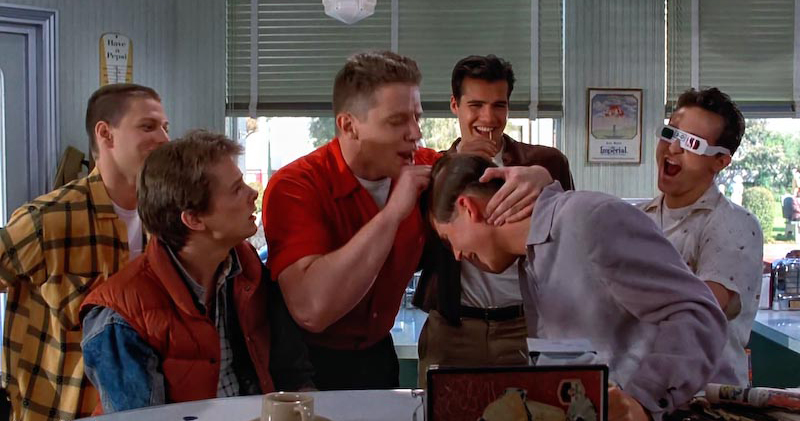
What Doesn’t Work:
None of the film’s various glossed over or totally ignored details actually detract from the film, but there is one story cheat that slightly bothers me — what the hell happened to the Libyans? Last we see of them, they crash into that small wooden booth after Marty reaches 88 mph. They didn’t blow up or anything. That means they’re still sitting there, very much alive and angry, when Marty discovers that Doc Brown is wearing a bulletproof vest. The Libyans are still in the parking lot!! Can’t they see Brown and Marty? Wouldn’t they circle back to see if Brown has any of the plutonium in his truck? Cause you know what? He does have the plutonium in his truck. Did they seriously just want to kill him, and then split? That seems odd. And in that case it is a good thing Doc immediately travels to the future, because if killing him was that important they’d presumably notice when he was no longer dead in a couple years.
For a film this well-constructed, it does go for some lazy laughs here and there. It is a pet peeve of mine in movies when our smart, clever hero is incapable of not accepting extremely obvious ramifications of the high-concept they are caught up in — such as a time traveler repeatedly forgetting that they’re in the past. Marty saying that his family has two TVs is funny, because yeah, a teen in 1985 wouldn’t immediately be thinking about how expensive TV sets were in 1955. But actually getting into a small debate about whether or not he had already seen an episode of The Honeymooners even after another character tells him the episode is brand new? BTTF is better than that. Then there are a few small out-of-character gags. The Doc laughing at the idea of actor Ronald Reagan being president is perfect. But being confused by Marty’s use of the word “heavy,” and presuming it may mean that gravity has changed in the near future. Come on. This guy invented a fucking time machine. He’s eccentric, but he’s a genius. A) Why would a scientist think the Earth’s gravity might change in thirty years? B) Does he not know what slang is? The 1950s had slang just as ridiculous as the 1980s. And this is a guy who liberally uses the expression “Great Scot,” which is nonsense itself. That said, I laughed at all these jokes when I was a little kid. So there you go.
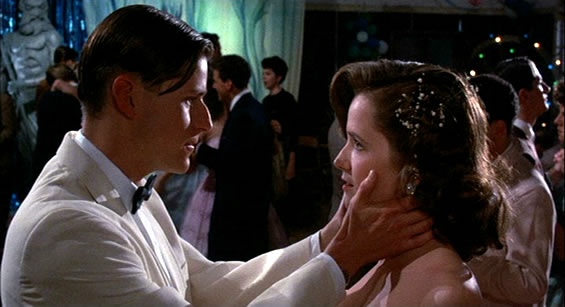
Best Biffism: “So, why don’t you make like a tree and get outta here?”
Marty’s Best Contribution to History: Invention of rock’n’roll.
Marty’s Best Use of Future Superiority: Using skateboarding skills to outwit Biff in a car chase. Also, using Van Halen to terrify George into asking out Lorraine.
Time Travel Murkiness: The movie implies that Marty inspires Chuck Berry to invent rock’n’roll. Does that mean that without Marty’s intervention Chuck Berry wouldn’t have become an influential rock pioneer? Or was he going to do that anyway? Did he recreate “Johnny B Goode” from what he heard over the phone? Or was his reaction, “What the fuck?! That’s the song I’m writing right now!”
Most Rosy View of the Past: When Biff’s goons encounter the all-black band performing at the school dance, they call the band “spooks” and then one says, “Look, I don’t wanna mess with no reefer addicts, okay?” Then the band gets pissed and chases them off, seemingly to beat the shit out of them. In 1955 such an action – black adults menacing some white teens – would surely get the Marvin Berry band beaten by police and/or arrested.
How the Characters Could Have Better Used Time Travel: He could have immediately told Doc Brown about the Libyans, which would have given the Doc thirty years to scheme a way around not getting killed other than wearing a bullet proof vest, which would have rendered that timeline obsolete and thus Marty never would have been forced to travel back to 1955. Also, why does Marty only give himself ten minutes to save Doc in the present? You’re in a time machine, man. You could go back a whole day, or more. Maybe you could stop Biff from wrecking your family’s car or redo your band’s audition while you’re at it. Ten minutes?
Should There Be a Sequel: I will commit suicide if you don’t let me know what happens to them in the future. Do you hear me Universal Pictures?! My blood will be on your hands!!
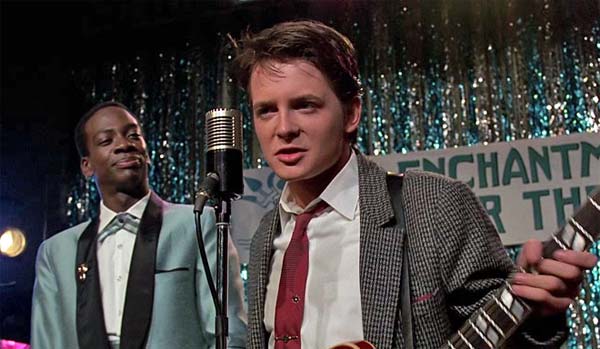
Up Next: Back to the Future II
previous franchises battled
Alien
Critters
Death Wish
Hellraiser
Home Alone
Jurassic Park
Lethal Weapon
Leprechaun
Meatballs
The Muppets
Phantasm
Planet of the Apes
Police Academy
Predator
Psycho
Rambo
Tremors